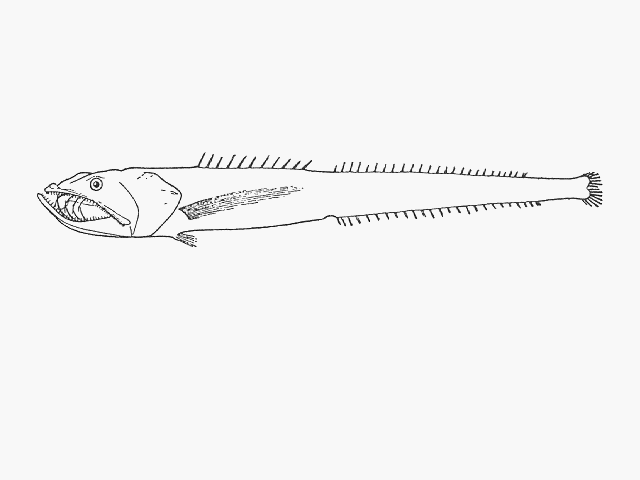| Chiasmodontidae (Snaketooth fishes) |
| 19.27 cm SL (male/unsexed) |
|
bathypelagic; marine; depth range 200 - 4465 m |
| Circumglobal: equatorial, tropical, and subtropical regions, in the Atlantic from 38° N
to 21° S; a single record in the western Indian at 8° S, 31° S; in the Pacific 27° N to 33° S. |
|
This species can be distinguished from its congeners except K. macrodon by the ascending process of premaxilla with a strong concavity limited anteriorly by bony crest (vs. ascending process of premaxilla flat or with gentle concavity, anterior bony crest absent). It further differs from K. colubrina, K. falx, K. indica, and K. parri by the teeth in lateral series of premaxilla and dentary 12-25, type 4, needle-like (vs. teeth in lateral series of premaxilla with ventral attachment, recurved in parri; 5-11, caniniform, type 4, slightly curved in indica and falx and recurved in colubrina); from K. macrura, teeth in lateral series of premaxilla and dentary type 4, needle-like, extending to the end of dentigerous area, teeth with ventral attachment absent in lateral series (vs. teeth in lateral series of premaxilla and dentary need-like in anterior third and fourth, respectively, followed by teeth with ventral attachment, recurved in posterior areas). It is distinguished from K, macrodon by the teeth in mesial series of premaxilla and dentary, 4-5, modally 5 (vs. teeth in mesial series of premaxilla teeth 6-9, modally 7, of and dentary 7-9, modally 8) (Ref. 75596). |
| Most adults have been taken in hauls in depths exceeding 1,000 m but a number of adults have been taken in hauls in depths between 500 to 1,000 m (Ref. 6944). |
|
Least Concern (LC); Date assessed: 14 July 2014 Ref. (130435)
|
| harmless |
Source and more info: www.fishbase.org. For personal, classroom, and other internal use only. Not for publication.

